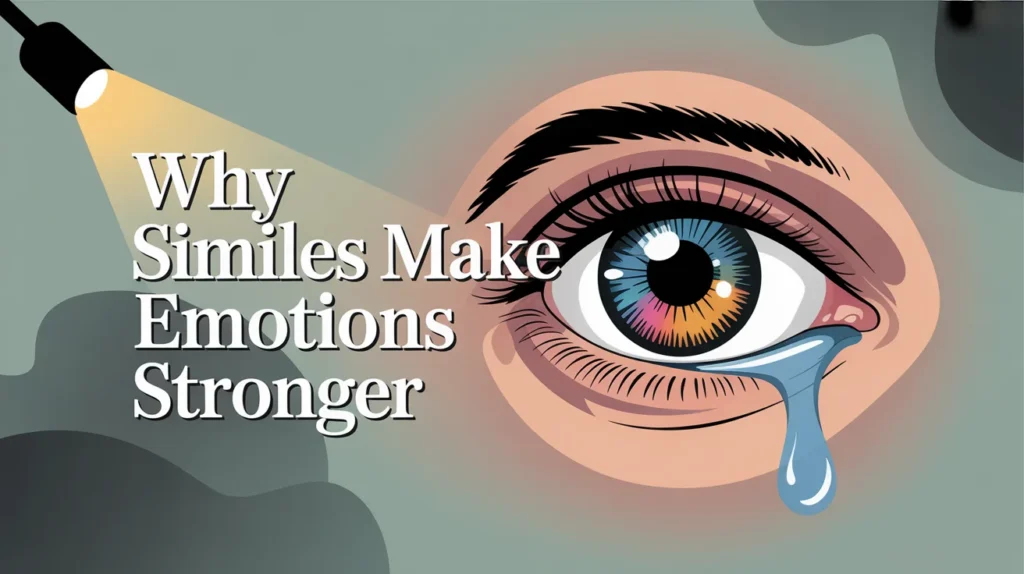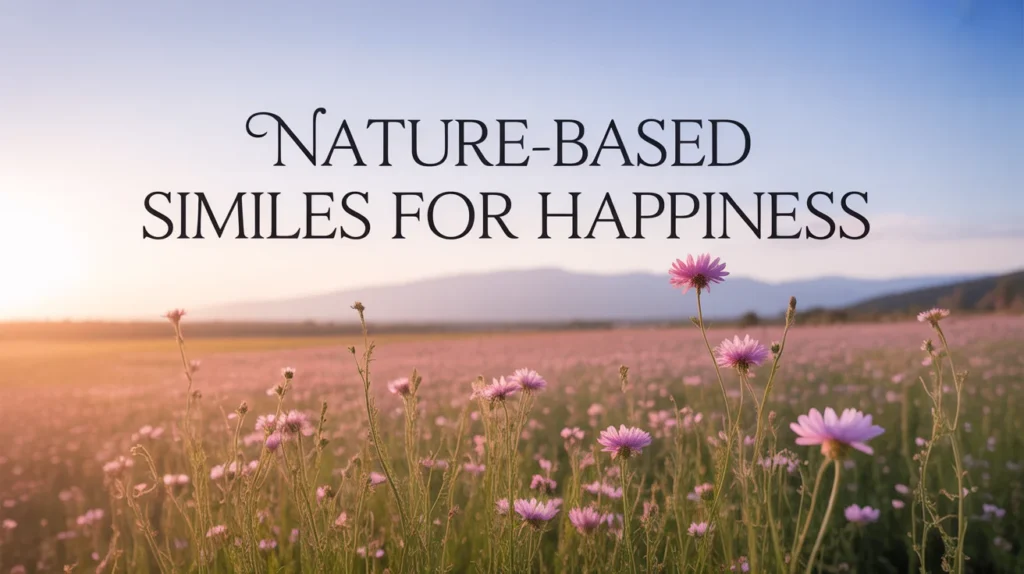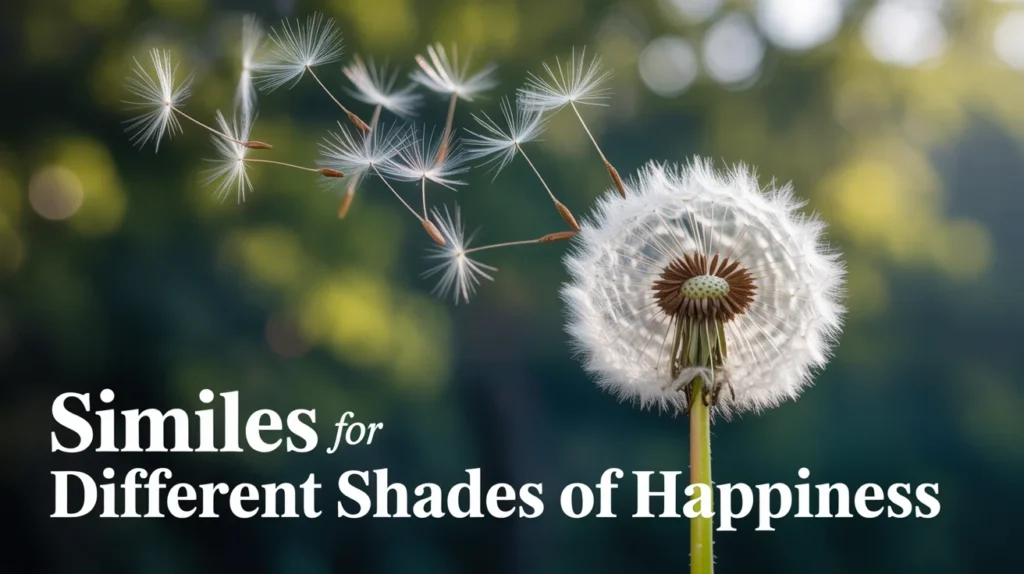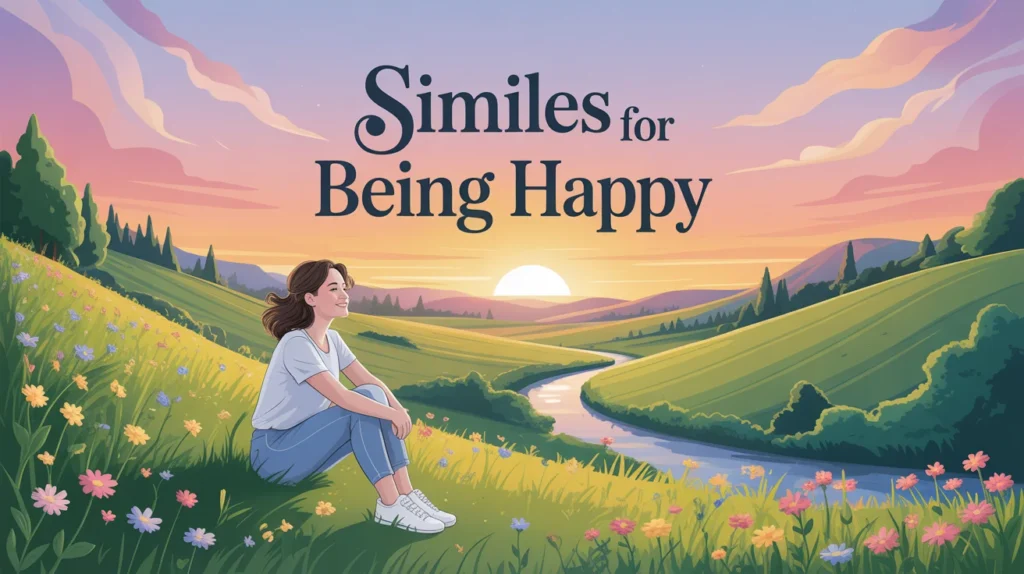Happiness is one of the most universal emotions, yet describing it vividly can be tricky. That’s where similes for being happy come in — they turn simple emotions into powerful imagery.
When you say someone is “as happy as a lark” or “as cheerful as sunshine,” you’re not just saying they’re happy — you’re painting joy in color.
In this guide, we’ll explore creative and meaningful similes for happiness — their origins, meanings, and how to use them naturally in writing, poetry, and everyday conversation. Whether you’re a student, writer, or English learner, this article will help you find the perfect way to express joy.
What Are Similes and Why They Matter
A simile is a figure of speech that compares two things using “like” or “as.”
It makes language more vivid and expressive.
Example:
“She was as happy as a child on their birthday.”
This instantly paints a picture — warm, joyful, and full of life. Similes for happiness let readers feel the emotion instead of just understanding it.
Why Similes Make Emotions Stronger

- They create imagery: You can almost see the happiness.
- They add creativity: “I’m as happy as a sunflower facing the sun” sounds far more vivid than just “I’m happy.”
- They connect emotionally: Relatable comparisons evoke real feelings.
- They enrich writing: Perfect for poetry, stories, speeches, or even casual talk.
Common Similes for Being Happy
| Simile | Meaning | Example |
|---|---|---|
| As happy as a lark | Extremely cheerful | She’s as happy as a lark on sunny mornings. |
| As happy as a clam | Content and comfortable | After the exams, I felt as happy as a clam. |
| As happy as can be | Fully joyful | The kids were as happy as can be after winning. |
| Like a kid in a candy store | Overjoyed and excited | He was like a kid in a candy store when he saw his new bike. |
| As happy as sunshine | Radiantly joyful | Her smile was as happy as sunshine on a cold day. |
| Like a bird with a new song | Cheerful and lively | After the good news, he was like a bird with a new song. |
| As happy as springtime | Fresh and full of life | Their love felt as happy as springtime itself. |
| Like a puppy with a new toy | Playfully excited | She was like a puppy with a new toy after getting her promotion. |
| As happy as a bee in a flower field | Productively joyful | He’s as happy as a bee in a flower field when he’s painting. |
| As happy as a rainbow after rain | Hopeful and bright | After recovering, she felt as happy as a rainbow after rain. |
These similes capture many shades of happiness — from calm and peaceful to energetic and radiant.
Creative and Modern Similes for Happiness
Traditional similes are timeless, but modern writing calls for fresh expressions that connect with today’s world.
| Modern Simile | Meaning / Context |
|---|---|
| As happy as Wi-Fi with full bars | Perfect for tech humor |
| Like a playlist full of favorite songs | Relatable and modern |
| As happy as a gamer on level-up day | Great for gaming fans |
| Like a phone at 100% battery | Signifies complete satisfaction |
| As happy as a fan meeting their idol | Ideal for pop culture or social media |
| Like sunshine through a rainy window | Poetic yet relatable |
| As happy as morning coffee on a Monday | Comfort and relief |
| Like a traveler seeing the sea for the first time | Deep, emotional joy |
| As happy as confetti at a celebration | Festive and lively |
These expressions sound youthful, real, and emotionally charged — perfect for blogs, captions, or creative writing.
How to Use Similes for Happiness Naturally

Knowing similes is great — using them effectively is better.
1. Match the tone.
Romantic poem? Try “as happy as springtime.”
Casual blog? Go for “like a kid in a candy store.”
2. Keep it logical.
❌ “He was as happy as a dolphin in space.”
✅ “He was as happy as a dolphin leaping in waves.”
3. Use them sparingly.
Too many similes can overwhelm your reader.
Correct: She was as happy as a sunflower facing the sun.
Incorrect: She was as happy as a sunflower, a bird, and a rainbow all at once.
4. Add sensory details.
“She felt as happy as warm sunlight on her skin after days of rain.”
Similes for Happiness in Literature
Writers have always used similes to express joy beautifully:
- Wordsworth-inspired: “The child was as happy as a daffodil in the breeze.”
- Shakespearean style: “My heart is as light as laughter at dawn.”
- Modern poetic tone: “She was as happy as dawn breaking through sleepless nights.”
Similes help readers see and feel happiness the way the writer imagines it.

Nature-Based Similes for Happiness
Nature symbolizes renewal, warmth, and life — perfect for joyful imagery.
| Simile | Nature Element | Emotional Tone |
|---|---|---|
| As happy as the sun after a storm | Sunshine | Relief and renewal |
| Like flowers blooming in spring | Flowers | Joy and freshness |
| As happy as waves kissing the shore | Ocean | Serenity and contentment |
| Like dew on morning grass | Morning | Gentle happiness |
| As happy as a butterfly in bloom | Butterfly | Lighthearted joy |
These work beautifully in poetry, essays, and reflective writing.
Similes for Being Happy in Daily Life
Similes can make everyday talk sound more expressive and fun:
- “I’m as happy as a bird with a French fry!”
- “You look as happy as a dog with two tails.”
- “She’s as happy as a Friday afternoon.”
- “They were as happy as music on a road trip.”
- “He’s as happy as payday morning.”
These sound friendly and natural — perfect for storytelling or casual writing.
Similes for Different Shades of Happiness

| Type of Happiness | Example Simile |
|---|---|
| Childlike happiness | As happy as a kid on Christmas morning |
| Peaceful happiness | As happy as a cat in sunlight |
| Excited happiness | Like fireworks lighting up the night |
| Content happiness | As happy as tea in a warm cup |
| Proud happiness | As happy as a painter finishing a masterpiece |
| Romantic happiness | As happy as the moon dancing with stars |
| Spiritual happiness | As happy as the soul at sunrise |
Choosing the right type helps make your description more authentic and emotional.
Tips for Creating Your Own Similes
- Start with the emotion: Peaceful? Excited? Fulfilled?
- Think visually: Use images like light, music, waves, or dawn.
- Use “like” or “as”: Example — as happy as morning light dancing on glass.
- Keep it relatable: Simple, human experiences work best.
- Read it aloud: A good simile sounds natural, not forced.
FAQs
1. What’s the best simile for being happy?
It depends on context — classics like “as happy as a lark” or “like a kid in a candy store” never go wrong.
2. Can I use similes for happiness in professional writing?
Yes! Just keep it elegant, like “as happy as sunshine after rain.”
3. Are similes and metaphors the same?
No. A simile uses “like” or “as”; a metaphor doesn’t.
Simile: He was as happy as a bee.
Metaphor: He was a beam of sunlight.
4. How can I teach similes about happiness?
Use relatable examples, short poems, or visuals that connect happiness with common things like food, animals, or nature.
5. What are some funny similes for happiness?
Try “as happy as Wi-Fi with full signal” or “as happy as a dog finding bacon.”
Conclusion
Similes for happiness add color and life to your words.
From “as happy as a lark” to “like a phone at 100% battery,” every comparison brings emotion alive.
Whether you’re writing poetry, stories, or social posts, the right simile lets your readers feel the joy — not just read it.
So next time you’re smiling wide, don’t just say “I’m happy.”
Say you’re “as happy as the morning sun lighting up the sky.”

Jonathan Reed is a former English lecturer who believes good grammar builds confidence. He loves breaking down confusing grammar topics into easy, everyday explanations. When he’s not writing for GrammerPro, he enjoys reading classic literature and mentoring young writers.

